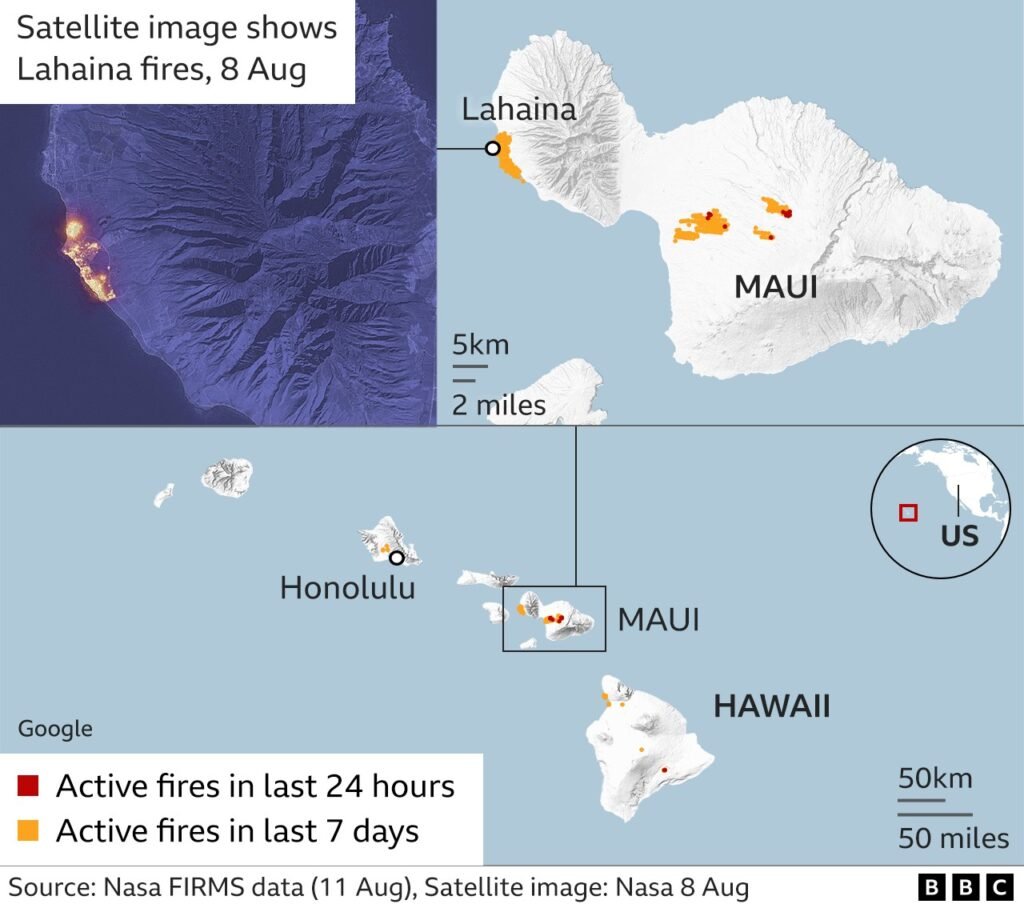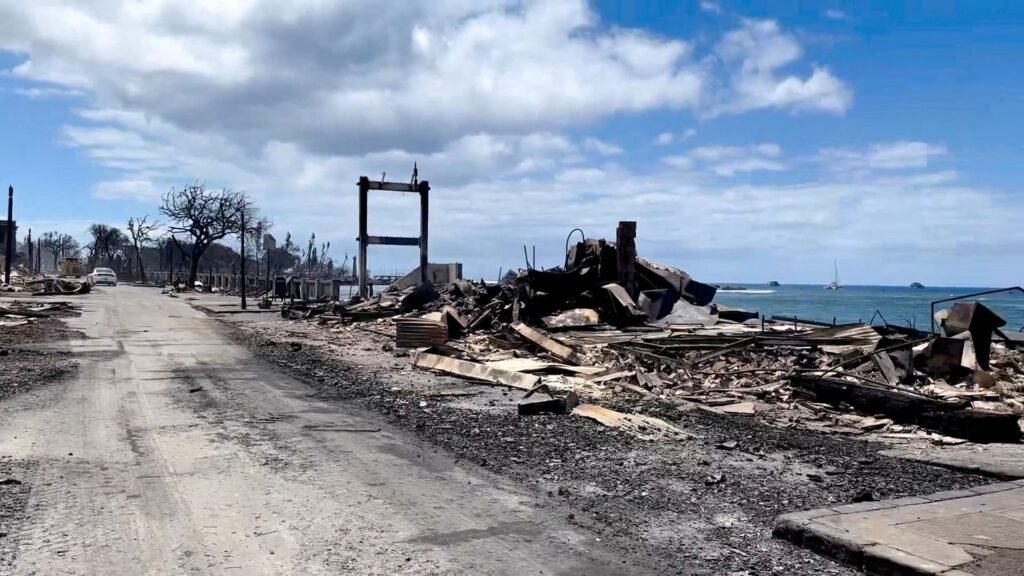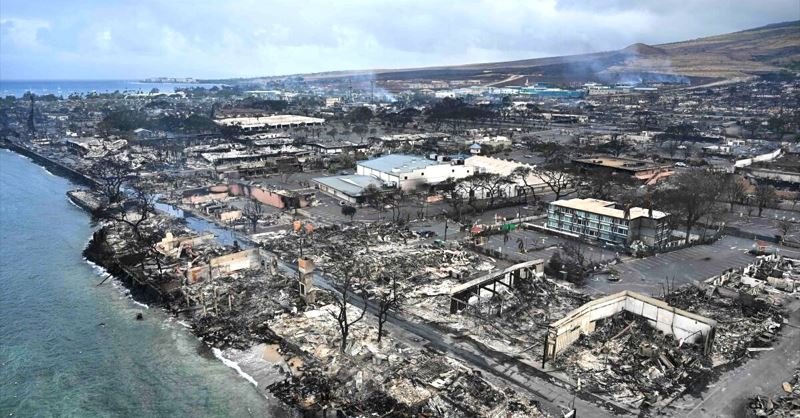Among the affected areas, the town of Lahaina suffered the most tragic fate, witnessing the untimely demise of 80 individuals
In the early days of August 2023, a series of devastating wildfires erupted across the picturesque landscapes of the U.S. state of Hawaii, with the island of Maui taking the brunt of the catastrophe. Fueled by ferocious winds, these fires tore through communities, leading to evacuation orders, extensive destruction, and a heartbreaking loss of lives. Among the affected areas, the town of Lahaina suffered the most tragic fate, witnessing the untimely demise of 80 individuals. As the situation continues to unfold, anxieties loom over the possibility of the disaster escalating even further, setting a grim record as the most catastrophic natural event in Hawaii’s history.
The Unrelenting Devastation

The impact of the wildfires has been nothing short of catastrophic. Entire communities have been evacuated, and countless structures have been reduced to ashes. Lahaina, once a vibrant town, now stands as a haunting testament to the unforgiving force of nature. The fires have claimed lives, displaced thousands, and inflicted an estimated toll of 1,000 structures destroyed. The recovery and rebuilding process looms ahead, anticipated to span several years and cost billions of dollars, indicating a long and arduous journey toward restoration.
Search and Recovery Efforts
The scale of the tragedy becomes more harrowing as officials express concerns about the potential discovery of more deceased individuals in the aftermath of the blaze. Search teams, aided by specially trained cadaver dogs, are painstakingly combing through the wreckage, a somber task that underscores the extent of the disaster’s toll. The fire’s rapid progression and sheer intensity have complicated these efforts, leaving bleak anticipation of an increased death count as the search continues.
A Lack of Warning
One perplexing aspect of this tragedy revolves around the absence of emergency sirens’ activation during the wildfire outbreak. Despite the state’s readiness with emergency systems designed to signal natural disasters and potential threats, there is no evidence that these systems were engaged during the fire’s initial stages. This has raised questions about whether residents were adequately alerted before their homes were engulfed by the inferno, contributing to the overall confusion and chaos during those critical hours.
Unraveling the Origin
The tragedy’s inception can be traced back to reports of a brush fire igniting in the town of Kula, situated approximately 35 miles (56 km) from Lahaina. While the disaster unfolded with the fire’s relentless advance, the National Weather Service had previously warned of high winds and parched conditions, creating a combustible environment for wildfires. These warnings were eventually lifted, but the damage had already been set in motion.
Nature’s Fury Amplified

Hawaii’s vulnerability to wildfires has intensified over recent decades, a phenomenon attributed to the proliferation of non-native vegetation and the escalating heat and dryness. Experts point to a significant increase in wildfire devastation, with the current disaster echoing this trend. Hurricane Dora’s winds, though hundreds of miles away in the Pacific Ocean, and a nearby low-pressure system have further contributed to the high sustained winds that facilitated the fire’s rapid spread.
Struggles in the Wake
In the wake of this tragedy, the people of Hawaii find themselves grappling with challenges on multiple fronts. The immediate aftermath of the fires saw individuals taking desperate measures to escape, including jumping into the sea to evade the relentless flames. Evacuation orders led to thousands seeking refuge in shelters, with many flying out of Maui via the Kahlul Airport. Proof of residency and evidence of hotel reservations were essential for individuals to gain access to the town of Lahaina, which bore the scars of the inferno.
Ongoing Crisis and Response
As the situation evolves, it is apparent that the road to recovery is fraught with obstacles. Health experts have raised alarms about the toxicity of the burnt regions, urging caution due to the hazardous particles suspended in the air. The need for essential resources like food, water, cleaning supplies, and hygiene products has surged, stressing the already limited resources available on the island. Despite these challenges, the spirit of unity and aid is exemplified by organizations like the Maui Food Bank, which is working tirelessly to provide assistance.
Currently, there are six operational shelters on Maui to assist the displaced and officials are formulating a plan to utilize hotels and tourist rental properties for their housing.
A Call for Aid and Unity
Hawaii’s plight has not gone unnoticed on the national stage. Vice President Kamala Harris and President Joe Biden are closely monitoring the crisis, acknowledging the severity of the situation. Efforts to secure disaster relief funding for Maui are being led by Senator Brian Schatz and Senate Majority Leader Chuck Schumer. The U.S. Health and Human Services have declared a public health emergency for the state, recognizing the multifaceted challenges arising from the disaster.
Conclusion
The wildfires that engulfed Hawaii in early August 2023 have left an indelible mark on the state’s history. The devastating impact on lives, property, and communities serves as a stark reminder of nature’s unyielding power. As Hawaii navigates the arduous journey of recovery, the spirit of solidarity and support from within the state and beyond remains a beacon of hope. In the face of tragedy, the resilience of the human spirit shines bright, illuminating the path toward healing and restoration.


